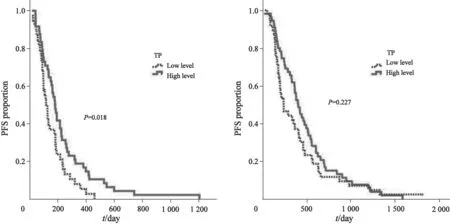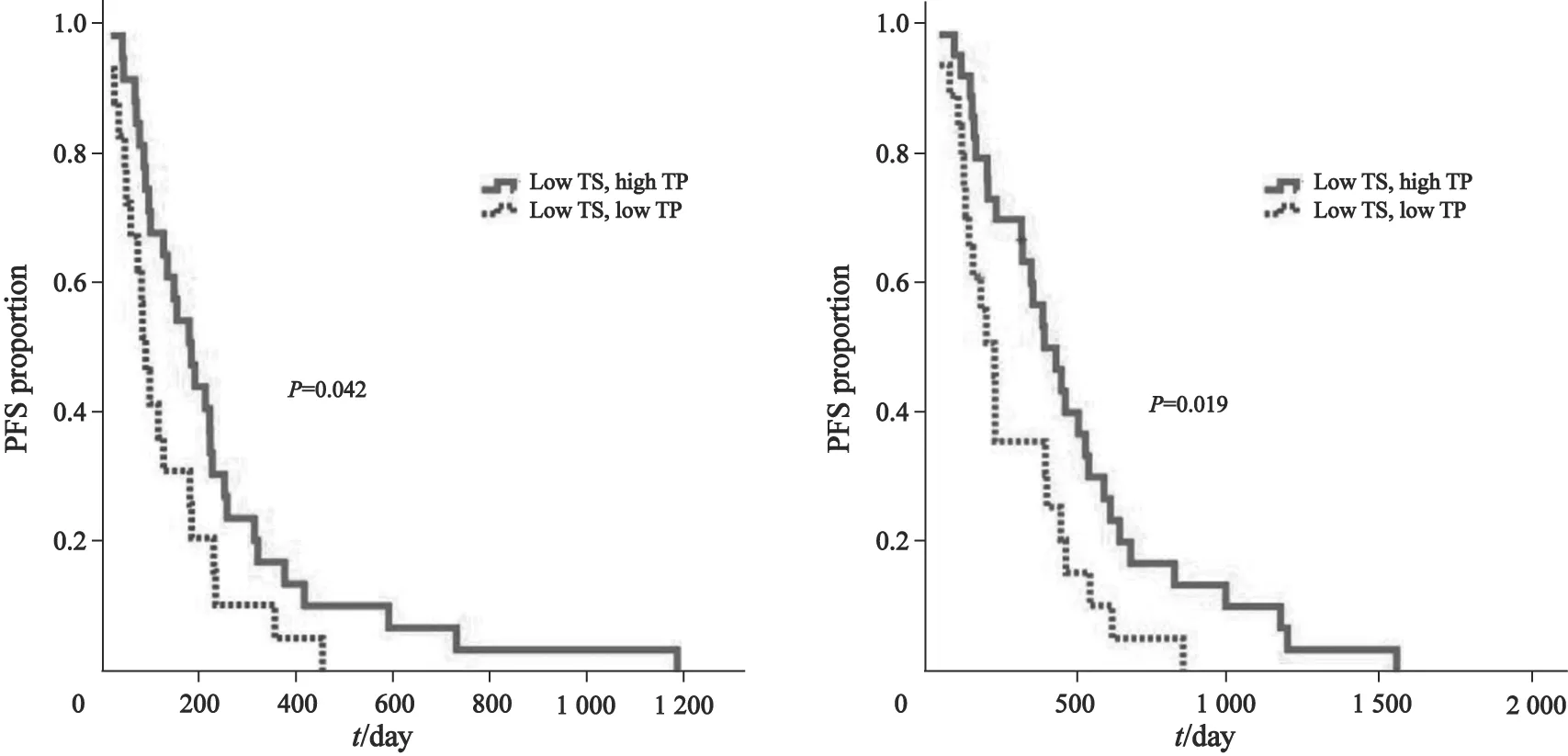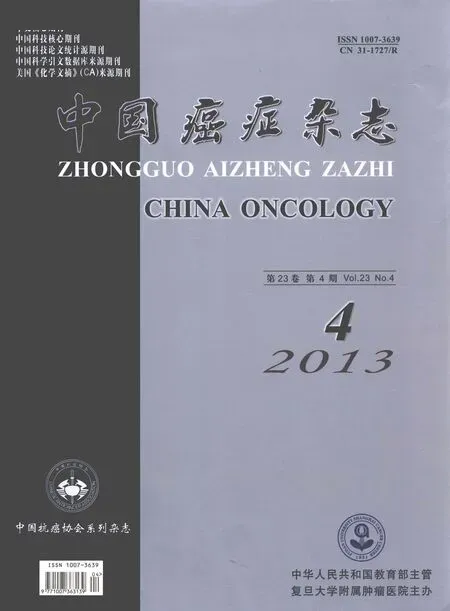晚期胃癌患者血清TS、TP表达水平与氟尿嘧啶为基础的化疗疗效及预后的相关性
2013-06-09
北京大学肿瘤医院暨北京市肿瘤防治研究所消化肿瘤内科,恶性肿瘤发病机制及转化研究教育部重点实验室,北京 100142
晚期胃癌患者血清TS、TP表达水平与氟尿嘧啶为基础的化疗疗效及预后的相关性
何琼 高静 王婷婷 陆明 沈琳
北京大学肿瘤医院暨北京市肿瘤防治研究所消化肿瘤内科,恶性肿瘤发病机制及转化研究教育部重点实验室,北京 100142
背景与目的:胸苷酸合成酶(thymidylate synthetase,TS)和胸苷酸磷酸化酶(thymidine phosphorylase,TP)是氟尿嘧啶类药物在体内代谢的关键酶,与胃癌患者接受氟尿嘧啶药物化疗疗效和预后密切相关。本研究旨在探讨晚期胃癌患者血清中TS、TP表达水平与氟尿嘧啶为基础的化疗疗效及预后的相关性。方法:收集2006年1月—2008年10月于北京大学肿瘤医院消化肿瘤内科治疗的109例一线接受氟尿嘧啶类药物为基础化疗的晚期胃癌患者化疗前的血清标本,运用酶联免疫吸附试验(ELISA)方法检测血清中TS、TP表达水平,分析TS、TP表达水平与化疗疗效及患者预后的相关性。结果:近端胃癌患者的TS表达水平高于远端胃癌患者(P=0.035),腹膜转移患者的TP表达水平明显低于无腹膜转移患者(P<0.001)。TS高表达患者临床获益率(clinical benefit rate,CBR)高于低表达患者(68.75% vs 47.1%,P=0.029),与患者生存无明显相关。TP高表达患者的中位无进展生存期(progression-free survival,PFS)与总生存期(overall survival,OS)均长于低表达患者(PFS:177 d vs 113 d,P=0.018;OS:399 d vs 234 d,P=0.227)。联合分析TS、TP表达发现,TS低表达且TP高表达患者的中位PFS和OS明显长于TS、TP均低表达患者(PFS:182 d vs 87 d,P=0.042; OS:429 d vs 223 d,P=0.019)。Cox多因素生存分析表明,在TS低表达时,TP表达水平是预后的独立影响因素(HR=1.913,95%CI:1.027~3.564,P=0.041)。结论:在接受氟尿嘧啶为基础化疗的晚期胃癌患者中,TS高表达患者的疗效较好,TP高表达患者的生存期较长,特别是TS低表达且TP高表达患者的生存期明显延长。
晚期胃癌;血清;胸甘酸合成酶;胸甘酸磷酸化酶;氟尿嘧啶
作为胃癌高发大国,中国的胃癌早诊率低,确诊时60%以上患者处于局部进展期或晚期。目前,国内外公认的晚期胃癌治疗原则是以化疗为主进行综合治疗。
在化疗药物中,氟尿嘧啶类药物(5-FU、卡培他滨、替吉奥等)是晚期胃癌患者的基础用药,但其单药有效率较低,临床常用的两药或三药联合方案有效率也仅有20%~40%,且患者中位总生存期仍不超过1年[1–3]。临床中发现,分期、组织学类型和治疗方案相同的患者,疗效却完全不同,这很大程度取决于患者的肿瘤生物学特点,因此,分子分型指导的临床个体化治疗尤为重要。
氟尿嘧啶类药物进入体内发挥作用过程中,与几种关键酶的活性密切相关,如胸苷酸合成酶(thymidylate synthetase,TS)、胸苷酸磷酸化酶(thymidine phosphorylase,TP)、二氢嘧啶脱氢酶(dihydropyrimidine dehydrogenase,DPD)等。目前,众多研究探索肿瘤组织中TS、TP表达水平与氟尿嘧啶类化疗的疗效及预后的相关性,大部分研究表明,TS低表达、TP高表达患者的疗效及预后较好,但仍有部分研究得出不一致的结论[4–8]。既往研究均在肿瘤组织中检测TS、TP表达水平,对于晚期胃癌患者来讲,内镜下获取化疗前活检肿瘤组织较困难,且创伤较大,因此简单易行的血清中标志物检测便成为关注热点。本研究旨在探讨晚期胃癌患者血清中TS、TP的表达水平,并分析其与氟尿嘧啶为基础的化疗疗效及预后的相关性。
1 资料和方法
1.1 患者入选标准
选择2006年1月—2008年10月于北京大学肿瘤医院消化肿瘤内科接受治疗胃癌患者109例,均符合下述入选标准:①病理组织学确诊为晚期胃癌;②所有患者接受一线氟尿嘧啶类药物为基础的联合化疗;③具有化疗前的血清标本;④具有详细的临床病历资料与疗效评估及随访结果。本研究通过北京大学肿瘤医院医学伦理委员会的审核批准。
1.2 疗效评估与随访
按照实体瘤评价标准1.1(response evaluation criteria in solid tumors 1.1,RECIST 1.1)标准每2个周期对患者进行1次疗效评估,疗效分为完全缓解(complete response,PR)、部分缓解(partial response,PR)、疾病稳定(stable disease,SD)与疾病进展(progressive disease,PD)。SD又细分为SD增大和SD缩小,其中SD缩小即轻微缓解(mild response,MR)才是获益的。此外,根据患者是否从化疗中获益,将患者分为两组:临床获益组(clinical benefit rate,CBR)(包括CR、PR及MR[肿瘤缩小<30%]患者)与非获益组(包括PD及SD增大[肿瘤增大<20%]患者)。根据下述公式计算临床获益率:CBR=(CR+PR+MR)/所有患者。无病进展期(PFS)是指从化疗开始至疾病进展的时间,总生存期(OS)是指从化疗开始至患者死亡的时间。采用门诊随访、电话随访等方式,末次随访时间2012年5月。
1.3 TS、TP表达水平检测
所有患者于化疗前清晨采集不抗凝静脉血3 mL,于4 ℃、2 500×g离心10 min后,将上清液于4 ℃、14 000×g离心5 min,血清分装后置-80 ℃保存备用。采用TS、TP ELISA试剂盒(USCN Life Science Inc.)检测血清中TS、TP的浓度,所有检测均重复3次。
1.4 统计学处理
统计学分析采用SPSS 16.0软件。TS、TP表达与临床病理特征及疗效的相关性进行卡方检验,Kaplan-Meier曲线和log-rank检验分析TS、TP表达与生存的关系,Cox回归进行多因素分析,P<0.05为差异有统计学意义。
2 结 果
2.1 患者基本资料
109例患者中,男性75例(68.8%),女性34例(31.2%);中位年龄57 岁(24~76 岁);具有肝转移、淋巴结转移、腹膜转移的患者分别为47例、90例和8例(表1)。患者接受一线治疗方案为:卡培他滨联合紫杉醇56例、卡培他滨联合顺铂或奥沙利铂±靶向药物34例、5-FU联合紫杉醇8例、FOLFOX方案6例、其他方案5例。接受化疗后每2个周期行影像学检查判定治疗效果,截止到2012年5月,99例患者具有临床评效结果,CR、PR、MR、SD增大及PD的患者分别为2、32、23、19与23例,临床获益率为57.6%;随让至2012年5月,共98例患者死亡,5例患者失访,6例患者生存,中位PFS和OS分别为155 d与331 d。
2.2 TS、TP表达与患者临床病理特征的相关性
选择纳入的所有患者检测的TS、TP的中位值(TS: 13.87 U/L,TP: 2767.5 U/L)作为cut-off值,将患者分为高表达者与低表达者。TS、TP表达与患者性别、年龄、肿瘤分化程度、KPS评分、肝转移、淋巴结转移等无明显相关性,但近端胃癌患者的TS表达水平显著高于远端胃癌患者(P=0.035),腹膜转移患者的TP表达水平明显低于无腹膜转移患者(P<0.001,表1)。

表 1 TS、TP表达水平与临床病理特征的关系Tab. 1 Associations between TS/TP expression and clinicopathological features
2.3 TS、TP表达与临床疗效的相关性
在具有临床评效的99例患者中,TS高、低表达者分别为48例与51例,TP高、低表达者分别为52例与47例。TS高表达患者的CBR明显高于TS低表达患者(68.75% vs 47.1%,P=0.029),TP高、低表达患者的CBR差异无统计学意义(61.5% vs 53.2%;P=0.401;表2)。
2.4 TS、TP表达与患者生存的关系
TS表达水平与患者的PFS和OS均无明显相关性(P >0.05)。TP高表达患者的中位PFS显著长于低表达患者(177 d vs 113 d;P=0.018),中位OS也长于低表达患者,但差异无统计学意义(399 d vs 234 d,P=0.227,表2,图1)。联合分析TS、TP表达发现,TS低表达且TP高表达患者的中位PFS和OS明显长于TS、TP均低表达患者(PFS: 182 d vs 87 d,P=0.042; OS: 429 d vs 223 d,P=0.019,图2)。 Cox多因素分析表明,在TS低表达时,TP表达水平是预后的独立影响因素(HR=1.913,95%CI:1.027~3.564,P=0.041)。

表 2 TS、TP表达水平与临床疗效及生存的相关性Tab. 2 Association between TS and TP levels and clinical benefit rate or survival

图 1 TP高、低表达患者的PFS和OS曲线Fig. 1 PFS and OS curves in patients with high or low TP levels

图 2 TS低、TP高表达患者与TS低、TP低表达患者的PFS与OS曲线Fig. 2 PFS and OS curves in patients with low TS and high TP levers or low TS and low TP levels
3 讨 论
氟尿嘧啶类药物是消化道肿瘤化疗的首选和基本用药,在体内主要通过TP催化转化为一磷酸脱氧核糖氟尿嘧啶核苷,后者可与TS、亚甲基四氢叶酸形成三联复合体,抑制TS的活性,阻碍DNA的合成,进而抑制肿瘤细胞的生长、增殖[4]。但这类药物化疗疗效及其不良反应个体差异很大。因此,从药物基因组学出发,探寻影响该药敏感性的预测指标,将为个体化治疗奠定基础。
近年来,关于氟尿嘧啶类药物疗效及预后预测标志物的研究越来越多,尤其是5-FU代谢途径中代谢酶类,比如TS、TP、DPD等。其表达水平与局部血药浓度密切相关,并且很可能影响到化疗敏感性[5]。大部分研究表明,TS低表达、TP高表达患者的疗效及预后较好,但仍有部分研究得出不一致的结论[4–8]。
本研究表明,TS高表达患者的临床获益率高于低表达患者,而TP高表达者患者的中位PFS和OS均长于TP低表达患者。联合分析TS、TP表达发现,TS低表达且TP高表达患者的中位PFS和OS明显长于TS、TP均低表达患者(PFS: 182 d vs 87 d,P=0.042; OS: 429 d vs 223 d, P=0.019)。既往研究报道,肿瘤组织中TS高表达患者接受术后氟尿嘧啶化疗的疗效高于TS低表达患者,与本研究结果一致[6–8]。但一项Meta分析(包括3 497例局部进展期或晚期的肠癌患者)结果却表明,TS低表达患者接受5-FU化疗的生存获益较高表达患者更明显[9]。Uchida等[10]检测了91例胃肠道肿瘤患者的TS表达水平,发现TS高表达患者发生疾病进展的风险较高,而TS低表达患者具有更好的生存优势。本研究未发现TS表达水平与患者生存的关系,原因可能是,TS在近端胃癌患者表达水平较高,而近端胃癌患者的预后又较差,无法得出TS表达与患者预后的明确结论。
TP,又名血小板内皮细胞生长因子(PDECGF),通过促进内皮细胞趋化移动发挥刺激血管生成的作用[11–12]。5-FU主要通过消耗TP成为活性代谢产物,同时也减少了血管生成、促进肿瘤细胞的凋亡。众多研究表明,TP表达水平与氟尿嘧啶类药物的疗效呈正相关。在多种肿瘤细胞中过表达TP后,细胞对5-FU的敏感性增加[13];Metzger等[14]发现,TP高表达的结肠癌患者接受5-FU化疗的效果较好;但仍有研究未发现TP表达水平与氟尿嘧啶类药物疗效的相关性[11–12,15]。本研究结果表明,TP高表达患者的临床获益率与低表达患者无明显差异,但中位PFS和OS却显著长于低表达患者。由于TP在肿瘤组织中的表达水平高于正常组织,肿瘤组织中由TP代谢产生的5-FU活性产物浓度较高,增加了肿瘤组织对氟尿嘧啶化疗药物的敏感性[12,16]。
虽然本研究结果表明,血清中TS高表达患者的临床获益率高于低表达患者,TP高表达患者的PFS和OS较长,对临床个体化治疗具有一定的指导价值,但还需大样本前瞻性临床研究验证方可明确是否能应用于临床个体化治疗。
[1] PARKIN D M, BRAY F, FERLAY J, et al. Global cancer statistics, 2002[J]. CA Cancer J Clin, 2005, 55(2): 74-108.
[2] JEUNG H C, RHA S Y, NOH S H, et al. Adjuvant 5-fluorouracil plus doxorubicin in D2-3 resected gastric carcinoma: 15-year experience at a single institute [J]. Cancer, 2001, 91(11): 2016-2025.
[3] HSU C H, YEH K H, CHEN L T, et al. Weekly 24-hour infusion of high-dose 5-fluorouracil and leucovorin in the treatment of advanced gastric cancers. An effective and lowtoxic regimen for patients with poor general condition [J]. Oncology, 1997, 54(4): 275-280.
[4] LONGLEY D B, HARKIN D P, JOHNSTON P G. 5-fluorouracil: mechanisms of action and clinical strategies[J]. Nat Rev Cancer, 2003, 3(5): 330-338.
[5] SOONG R, DIASIO R B. Advances and challenges in fluoropyrimidine pharmacogenomics and pharmacogenetics[J]. Pharmacogenomics, 2005, 6(8): 835-847.
[6] EDLER D, GLIMELIUS B, HALLSTROM M, et al. Thymidylate synthase expression in colorectal cancer: a prognostic and predictive marker of benefit from adjuvant fluorouracil-based chemotherapy [J]. J Clin Oncol, 2002, 20(7): 1721-1728.
[7] TAKENOUE T, NAGAWA H, MATSUDA K, et al. Relation between thymidylate synthase expression and survival in colon carcinoma, and determination of appropriate application of 5-fluorouracil by immunohistochemical method [J]. Ann Surg Oncol, 2000, 7(3): 193-198.
[8] YAMACHIKA T, NAKANISHI H, INADA K, et al. A new prognostic factor for colorectal carcinoma, thymidylate synthase, and its therapeutic significance [J]. Cancer, 1998, 82(1): 70-77.
[9] POPAT S, MATAKIDOU A, HOULSTON R S. Thymidylate synthase expression and prognosis in colorectal cancer: a systematic review and meta-analysis [J]. J Clin Oncol, 2004, 22(3): 529-536.
[10] UCHIDA K, DANENBERG P V, DANENBERG K D, et al. Thymidylate synthase, dihydropyrimidine dehydrogenase, ERCC1, and thymidine phosphorylase gene expression in primary and metastatic gastrointestinal adenocarcinoma tissue in patients treated on a phase I trial of oxaliplatin and capecitabine [J]. BMC Cancer, 2008, 8: 386.
[11] ICHIKAWA W, UETAKE H, SHIROTA Y, et al. Combination of dihydropyrimidine dehydrogenase and thymidylate synthase gene expressions in primary tumors as predictive parameters for the efficacy of fluoropyrimidine-based chemotherapy for metastatic colorectal cancer [J]. Clin Cancer Res, 2003, 9(2): 786-791.
[12] HATA K, FUJIWAKI R, NAKAYAMA K, et al. Expression of thymidine phosphorylase and vascular endothelial growth factor in epithelial ovarian cancer: correlation with angiogenesis and progression of the tumor [J]. Anticancer Res, 2000, 20(5C): 3941-3949.
[13] TOI M, ATIQUR R M, BANDO H, et al. Thymidine phosphorylase (platelet-derived endothelial-cell growth factor) in cancer biology and treatment [J]. Lancet Oncol, 2005, 6(3): 158-166.
[14] METZGER R, DANENBERG K, LEICHMAN C G, et al. High basal level gene expression of thymidine phosphorylase (platelet-derived endothelial cell growth factor) in colorectal tumors is associated with nonresponse to 5-fluorouracil [J]. Clin Cancer Res, 1998, 4(10): 2371-2376.
[15] SALONGA D, DANENBERG K D, JOHNSON M, et al. Colorectal tumors responding to 5-fluorouracil have low gene expression levels of dihydropyrimidine dehydrogenase, thymidylate synthase, and thymidine phosphorylase [J]. Clin Cancer Res, 2000, 6(4): 1322-1327.
[16] FOX S B, WESTWOOD M, MOGHADDAM A, et al. The angiogenic factor platelet-derived endothelial cell growth factor/thymidine phosphorylase is up-regulated in breast cancer epithelium and endothelium [J]. Br J Cancer, 1996, 73(3): 275-280.
Correlations between serum levels of TS, TP and clinical outcome in Chinese patients with advanced gastric cancer receiving fluorouracil-based chemotherapy
HE Qiong, GAO Jing, WANG Ting-ting, LU Ming, SHEN Lin (Key Laboratory of Carcinogenesis and Translational Research, Ministry of Education; Department of GI Oncology, Peking University Cancer Hospital & Institute, Beijing 100142,China)
SHEN Lin E-mail: lin100@medmail.com.cn
Background and purpose: Thymidylate synthetase (TS) and thymidine phosphorylase (TP) are the key enzymes in metabolism of fluorouracil drugs, and related to the chemotherapy response and prognosis in gastric cancer patients receiving fluorouracil-based chemotherapy. This study aimed to investigate the correlations between serum levels of TS, TP and clinical outcome in Chinese patients with advanced gastric cancer receiving fluorouracilbased chemotherapy. Methods: Serum samples prior to chemotherapy were collected from 109 patients receiving first-line fluorouracil-based chemotherapy in Peking University Cancer Hospital from Jan. 2006 to Oct. 2008. TS and TP levels were analyzed using ELISA assay. Results: TS expressions was higher in patients with proximal gastric cancer than those in patients with distal gastric cancer primary (P=0.035), and TP expression in patients with peritoneal metastasis was significantly lower than those in patients without peritoneal metastasis (P<0.001). Patients with high level of TS had higher clinical benefit rate (CBR) than patients with low level of TS (68.75% vs 47.1%, P=0.029), but no difference was seen between TS levels and survival. The median progression-free survival (PFS) and overall survival(OS) in patients with high level of TP were higher than those in patients with low levels of TP (PFS: 177 d vs 113 d, P=0.018; OS: 399 d vs 234 d, P=0.227). Combined analysis of TS and TP, the results indicated that patients with low TS and high TP levels had significantly longer PFS and OS than patients with low TS and high TP levels (median PFS: 182 d vs 87 d, P=0.042; median OS: 439 d vs 233 d, P=0.019). Cox multivariate regression analysis demonstrated that TP was an independent prognostic factor in patients with low level of TS (HR=1.913, 95% CI: 1.107–3.564, P=0.041). Conclusion: In Chinese patients with advanced gastric cancer receiving first-line fluorouracil-based chemotherapy, patients with high level of TS have a better efficacy and patients with high level of TP have a better prognosis. Especially, patients with TS low and TP high level have the longest PFS or OS.
Advanced gastric cancer; Serum; Thymidylate synthetase; Thymidine phosphorylase; Fluorouracil
10.3969/j.issn.1007-3969.2013.04.009
R735.2
:A
:1007-3639(2013)04-0292-06
2012-10-26
2013-03-15)
沈琳 E-mail:lin100@medmail.com.cn
